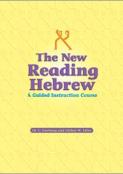- Home
- Play & Learn Home
- Online Enrichment
- Experience Modern Israel
- Israel It's Complicated
- Jewish and Me
- Jewish Holidays Jewish Values
- Jewish Values in Genesis and Jewish Values in Exodus
- Min Ha’aretz
- Our Place in the Universe
- Simply Seder
- The Prophets: Speaking Out for Justice
- Making T'filah Meaningful
- Make, Create, Celebrate
- Yom Haatzmaut Resources
- Hebrew Apps
- About The OLC
- What is the OLC?
- Introduction
- Get Started
- Resources
- OLC Content
- Parent Materials
- See My OLC Classes
- Store
Jazzing Up Prayer Classes
By Barbara Binder Kadden and Bruce Kadden
 Editor's Note: A.R.E. teacher resources are the perfect complement to Behrman House textbooks. Below you will
Editor's Note: A.R.E. teacher resources are the perfect complement to Behrman House textbooks. Below you will  find ways to use Teaching Tefilah: Insights and Activities on Prayer to enrich prayer study with Hineni, including creative writing exercises, art projects, as well as music, drama, and other activities.
find ways to use Teaching Tefilah: Insights and Activities on Prayer to enrich prayer study with Hineni, including creative writing exercises, art projects, as well as music, drama, and other activities.
1. Bring the Torah to life by showing students that (a) many of our prayers are drawn from the Torah and (b) the Torah reading is an integral part of the Shabbat morning prayer service.
-
Visit the sanctuary with the students. With the permission—and, if you need it, the help—of the Rabbi, Cantor, Director of Education, or Executive Director, open a Torah scroll to show students the prayers that are taken from the Torah. For example, before or after students have learned the Sh’ma, open the Torah to Deuteronomy 6:4. Ask students to compare the Sh’ma as it appears in the Torah to the Sh’ma in their textbooks or in a siddur. Discuss the significance of the enlarged ayin in the word sh’ma and dalet in the word ehad (see Hineni 1, Chapter 3, p. 32). Challenge students to read the Sh’ma from the Torah without the vowels!
-
Before or after studying V’shamru (Hineni 2, Ch. 8), open the Torah scroll to Exodus 31:16-17. Ask students to identify words they know. Although there are no vowels, they should be able to recognize Shabbat, Yisrael, brit, olam, l’olam, Adonai, ha’aretz. Discuss what it means to keep or guard Shabbat.
-
When studying the prayers for the Torah service in Hineni 3, attend a Torah service, individually or as a class, pretending to be reporters and closely observing what happens. Ask the students to recall everything that occurred. List each step on the board. Role play a Torah service in the sanctuary assigning students the role of rabbi, cantor, congregants receiving aliyot, the person who lifts the Torah, and the person who rolls the Torah and dresses it. Afterward, discuss the experience.
2. Beautify and enrich the physical classroom environment with creative art projects illustrating prayer themes.
-
Create a bulletin board display or photo album to illustrate the blessings. For example, after students have learned the blessings for Friday night, (Hineni 1, Ch. 7), bring in candles, candlesticks, a Kiddush cup, hallah board, hallah, and hallah cover, and a camera. Have each student pose, as if he or she were leading the blessing for each item. Create a Shabbat bulletin board with the photos. Or have students make their own albums to take home. Have students write the appropriate blessing above or below each photo.
-
After studying Birkat Shalom (Hineni 2, Ch. 5), discuss the theme of peace. Distribute magazines or newspapers to the students and ask them to find pictures reflecting the theme of peace. Have each student make a collage with the pictures and display on a bulletin board.
-
After students have learned the blessings before and after the Torah reading (Hineni 3, Ch. 3), take them to the sanctuary and have them stand in front of the open Ark, holding a Torah scroll. Take a photo of each student, mount it on a piece of construction paper, and ask each student to write how he or she felt when holding the Torah. Post the photos on a bulletin board.
3. Show students how the physical movements associated with the prayers reflect the prayer’s themes and help make the prayer experience active.
-
Ask students how we show respect to others (examples: peers—listening when they speak, returning borrowed items, inviting them to join your group; adults—helping around the house, speaking politely, offering your seat). Explain the custom of bowing before a king or queen to show respect. Demonstrate to the class how this idea is reflected in our bowing during the Bar’chu (Hineni 1, Ch. 1) and the Amidah (Hineni 2), thus reflecting our view of God as a sovereign.
-
When teaching the K’dushah in Hineni 2, Chapter 3, teach students why it is traditional to rise on one’s toes three times when saying "kadosh, kadosh, kadosh." Practice the movements, then read with your class the biblical source for the K’dushah (Isaiah 6:3). Discuss how rising on one’s toes reflects that the words were spoken by angels.
-
Ask students to describe what happens when the Torah is taken from the Ark. How do congregants show their respect for the Torah? With your class compose a "Guide to Torah Etiquette," which includes the variety of ways that one might show respect for the Torah, for example, by decorating the Torah with fine garments and ornaments, standing when the Torah is taken from the Ark, and reaching out to touch it with a siddur or tallit.
4. Use creative writing to help students expand their understanding of the meaning and message of the prayers.
-
After reading and discussing the meaning of V’ahavta (Hineni 1, Ch. 4), ask students to write a short story or poem entitled: "Loving God with all one’s heart," "Loving God with all one’s soul," or "Loving God with all one’s might." Ask for volunteers to read their writing aloud.
-
Have students create an acrostic poem using the word "peace" or "shalom" after studying Oseh Shalom (Hineni 2, Ch. 6) or another prayer for peace. In an acrostic poem each line begins with one of the letters of a word or phrase.
-
At the end of the Torah service, we sing Etz Hayyim Hi, comparing the Torah to a Tree of Life. Direct your class to complete the following sentence: "The Torah is like a tree of life because... ."
5. Encourage creative expression by adding drama to students’ prayer study.
-
When teaching blessings of mitzvot in Hineni 1, choose one student to act out a ritual that requires a blessing of mitzvah, such as lighting Shabbat candles, putting on a tallit, shaking the lulav, or listening to the sound of the shofar. Other students should guess the answer by reciting the appropriate blessing. The first student with the correct answer gets to act out the next ritual.
-
To extend your study of the G’vurot (Hineni 2, Ch. 2), divide your class into groups and give each group one of the following phrases from the G’vurot: m’chalkeil hayyim b’hesed ("sustains the living with kindness"); someih noflim ("supports the fallen"); rofei holim ("heals the sick"); matir asurim ("frees the captive"); and either m’hayei hakol ("gives life to all") or m’hayei hameitim ("gives life to the dead"). Each group should prepare a short skit to demonstrate their phrase from the prayer.
-
Have students create a storyboard to illustrate each phrase from the Hashkiveinu (Hineni 3, Ch. 9). Each cell of the storyboard should contain a phrase from the prayer and an illustration that depicts the phrase. Then have students act out the story.
6. Bring joy to prayer study with music.
-
Teach students the melody for Mi Chamocha (Hineni 1, Ch. 5), a prayer which comes from the majestic Song of the Sea (Exodus 15: 1-18), sung by the escaping Israelites after the parting of the Red Sea. Read Exodus 14 as background to Mi Chamocha.
-
Invite the cantor or music specialist to teach a variety of melodies for L’cha Dodi (Hineni 2, Ch. 7). Have students present a L’cha Dodi concert at a Shabbat service.
-
Teach students to sing Al Sh’loshah D’varim (Pirkei Avot 1:2), which is often sung as part of the Torah service (Hineni 3, Ch. 5). Discuss why the rabbis thought the world was supported by Torah, worship and acts of loving-kindness.
-
By weaving these activities and others from Teaching Tefilah and Hineni Teacher’s Guides into your Hebrew curriculum, you can add energy to your classroom and enthuse and motivate students in their prayer study.










